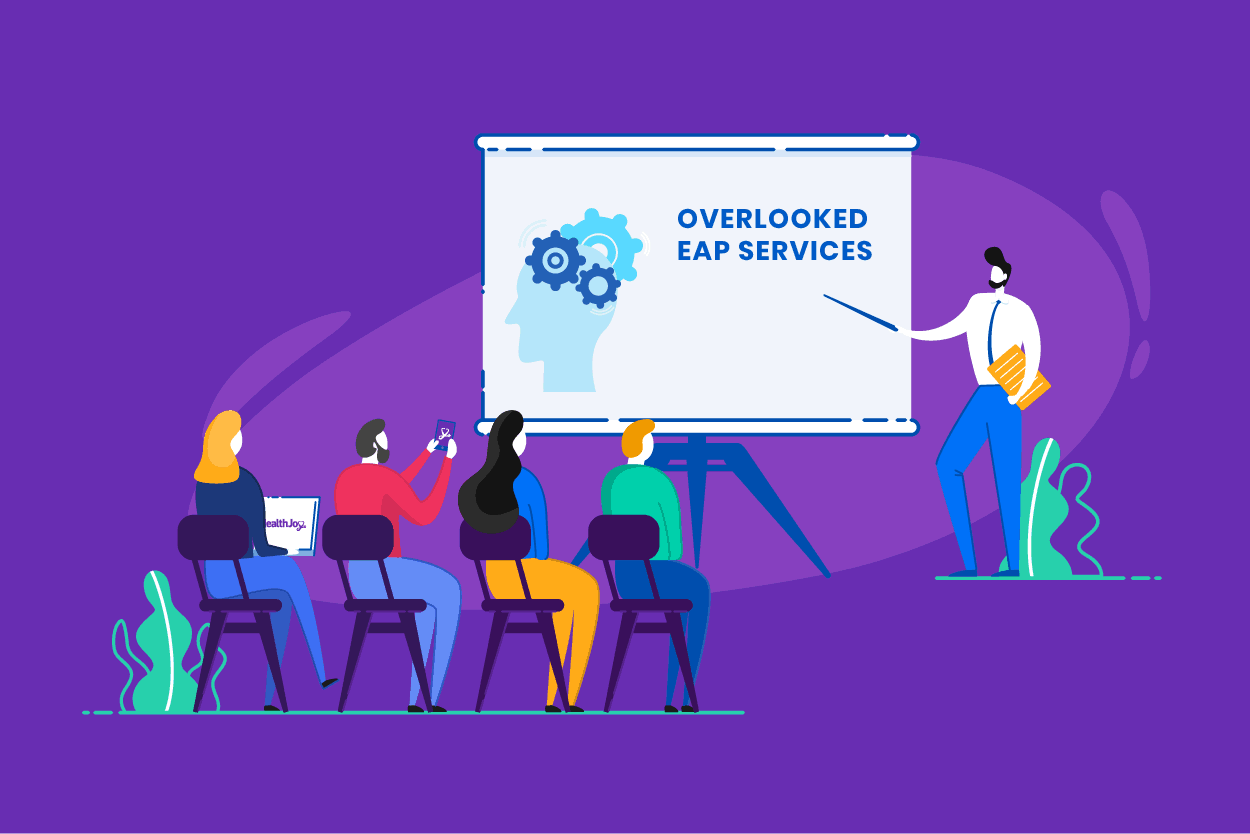Four Reasons Your Employees Don’t Use EAP Benefits
On average, organizations spend over $15,000 per year on each employee experiencing mental health issues. Employers are constantly searching for...
Connected Navigation Platform
Guiding to high-value care
Behavioral Health
Foster a mentally healthy workplace
EAP
Supporting holistic wellbeing
Virtual MSK Care
Reimagining musculoskeletal care
Virtual Primary Care
Powered by smart navigation
Surgery Centers of Excellence
Best-in-class surgical outcomes
Virtual Urgent Care
Immediate care, any hour of the day
Chronic Care
A new approach to chronic care
Integrations
Flexible to any strategy

When you think of supporting employee mental health through a pandemic, a counseling benefit might be the first thing that comes to mind. But what other lifelines could you offer employees?
Financial pressures, legal services, and substance abuse resources were always critical, but now they’re simply essential. The easy answer is one you likely already offer: an Employee Assistance Program (EAP).
Despite being carefully crafted to support a range of personal issues, EAP services are rarely used. If your utilization rates are low, you’re not alone. We often associate EAP’s with mental health, but if your employees aren’t exploring their EAP, they’re missing out on financial, family, and legal resources, as well. During this critical time, it’s worth revisiting how you highlight all the benefits of your EAP.
If your employees are thinking of their EAP at all, they might have a vague notion about mental health counseling. Yet you probably offer other helpful EAP services and resources that go far beyond short-term counseling (see our post Does Short-Term Counseling Really Work? for more).
Employee Assistance Programs evolved to address the problems most likely to impact employee performance. If it distresses and distracts employees, there’s probably an EAP resource to address it. For example, EAP’s typically include:
Resources to help employees manage their budgets, address debt, and more.
Free legal counsel for divorce, bankruptcy, and more.
Free legal and financial support for employees who want to pursue adoption.
Resources and support for caregivers
Though often offered through a third-party service, EAP’s can sometimes offer nurse lines and medical advice to employees
Short-term counseling and group support resources specifically for employees struggling with substance abuse
Support for employees struggling with trauma after incidents of workplace violence
Even if you already know your EAP program inside and out, it’s worth revisiting through the lens of what employees might need most during a pandemic. Now is the time to lock in your communication strategies so employees understand exactly how an EAP can help.
(Read our post “How to Help Employees Manage Coronavirus Anxiety” for more)
Helping employees make the most of your EAP means communicating its value, clarifying the details, and digging deep into employee education. Check these boxes to make sure you’re highlighting everything your EAP has to offer:
Lay groundwork with a solid benefits education strategy
During open enrollment, employees are primed to hear new information about benefits. Get ahead by refreshing your benefits education strategy. For example, if you aren’t adding anything new to your EAP this year, take this opportunity to highlight some of the underutilized services included in your EAP. Consider hosting a lunch-and-learn session to cover your EAP benefit, or dedicating a few more slides to EAP services. Given what we know about EAP utilization, it’s likely even long-time employees could use a refresher.
Follow up with monthly communications
With the basis of a strong employee education plan underfoot, it’s important to build on awareness with a year-round campaign. Regular benefits communications ensure that all your helpful benefits, from telemedicine to EAP, stay top-of-mind. Employees might not immediately think of these benefits when things go wrong, but that’s exactly when they’ll need EAP services most. These communications might take the form of emails, slack messages, webinars, or push notifications. If they already know exactly where to access their EAP—and that it’s free—they’re far more likely to turn to it first.
EAP’s are often buried in a benefits booklet and ignored. Here, we’ll share our best tips for helping employees navigate life with the help of your EAP.
When benefits are centralized in a single location, it’s simpler for employees to locate the resources they need when they need them. While our industry has focused on print booklets and brochures, others have innovated in apps. That means employees expect to be able to access benefits from their mobile devices. Printed benefits booklets are obsolete, and if they’re left in a vacant office, all bets are off. At the very least, employees should be able to quickly find phone numbers and information on your intranet or in the cloud. For the most seamless experience, gather all your benefits information together in a single app. We call this a benefits experience platform.
Under normal circumstances, offering support for employee benefits questions might be a matter of opening your door. When employees are remote or shifts are staggered, this becomes a little trickier. You may need to offer an anonymous tool, like Survey Monkey, so employees can ask questions about their benefits. This is especially helpful for services like EAP, which may carry a stigma. If your benefits experience platform offers live support, even better. Now is the time to make sure employees know it’s there. Give them simple directions for accessing support on their mobile device or from home.
We’re all facing challenges in the wake of COVID-19, and those challenges require us to rethink our benefits communication strategies. The good news is that your EAP already offers the support employees crave. It’s just a matter of making sure they know when and how to find it.

On average, organizations spend over $15,000 per year on each employee experiencing mental health issues. Employers are constantly searching for...

We’re approaching 2021 open enrollment under a cloud of mental health concerns. Employees are struggling like never before, and it might feel like...
In the years since I began opening up about my own family’s struggle with substance abuse, I’ve found that nearly everyone I know has a similar...